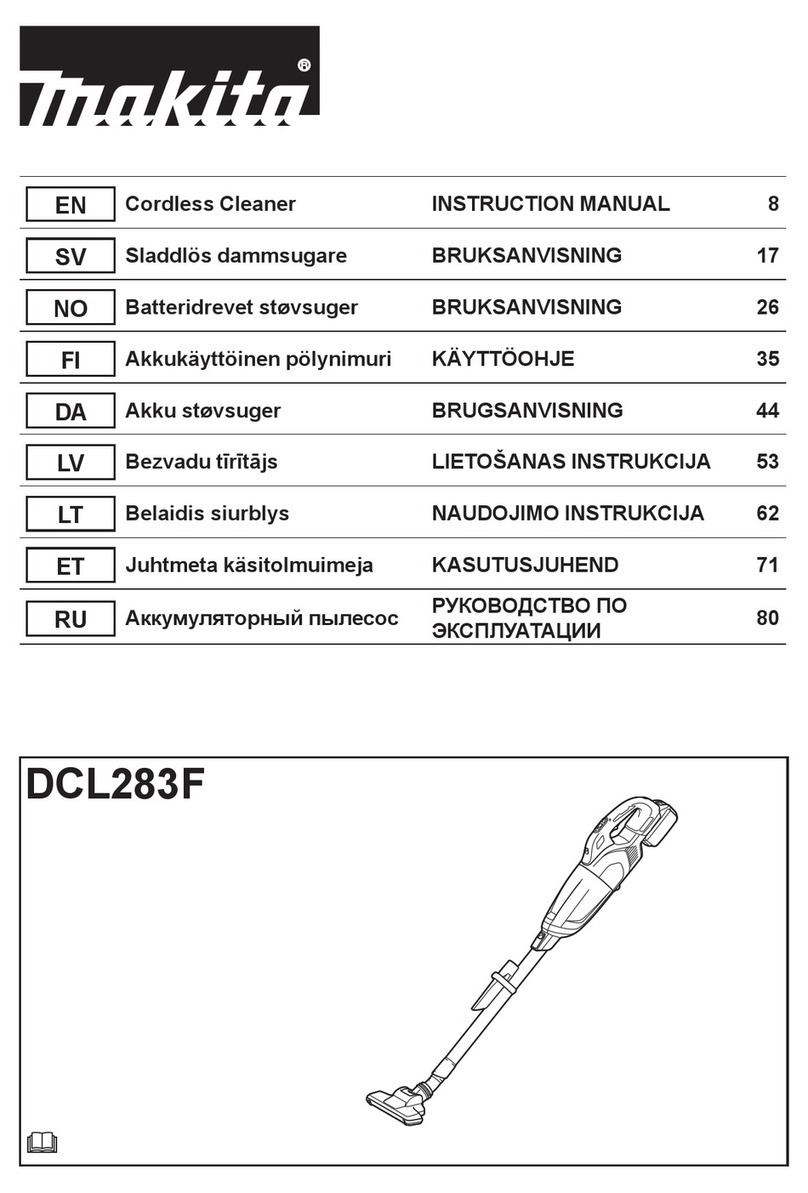Breconcherry Andantex Cyclone User manual

Breconcherry Cleaning Technology
Orbital cleaner Cyclone, Twister, Typhoon, Tempest, Tornado,
Tornado 4
Operating instruction (Translation from the original language)
430BAL011762EN_2

COPYRIGHT
These Operating Instructions are the English translation of the original operating
instructions in the sense of the EU Machinery Directive. This document is
protected by copyright. All rights reserved. The document may not, in whole or in
part, be copied, reproduced, translated or reduced to an electronic medium of
machine-readable form without the express permission of Breconcherry.
LEGAL NOTICE
_
We kindly request that you answer a few short questions about these Operating
Instructions. Use the following QR code or link to access the questionnaire:
https://www.ntgt.de/ra/s.aspx?s=367112X57707125X58087
430BAL011762EN_2
2 28.05.2018

TABLE OF CONTENTS
1General Information 5
1.1 Information on the Document 5
1.1.1 Binding Character of These Operating Instructions 5
1.1.2 Notes on the Illustrations 5
1.1.3 Symbols and Highlighting 5
1.2 Manufacturer address 6
1.3 Contact 6
1.4 EC Declaration of Conformity for Partially Completed Machines 7
2Safety 8
2.1 Intended use 8
2.1.1 Requirements for operation 8
2.1.2 Improper operating conditions 8
2.2 Operator’s Duty of Care 8
2.3 Subsequent changes 9
2.4 General safety instructions and dangers 9
2.4.1 Principles for safe operation 9
2.4.2 Environmental Protection 10
2.5 Supplementary Regulations 10
2.6 Qualification of personnel 10
2.7 Safety equipment 12
2.7.1 Signage 12
2.8 Residual dangers 13
2.9 Danger zones 13
3Description 15
3.1 Design 15
3.2 Functional description 16
4Transport and storage 17
4.1 Storage conditions 17
4.2 Transport 17
4.2.1 Scope of supply 17
5Technical data 18
5.1 Identification 18
5.2 Cyclone: 18
5.3 Twister: 19
5.4 Typhoon 19
5.5 Tempest 19
5.6 Tornado 20
5.7 Tornado 4 20
5.8 Resistance of Sealing Materials 20
5.9 Tools 22
5.10 Weights 23
6Assembly and installation 24
6.1 Safety notes 24
6.2 Notes on installation 24
6.3 Installation 24
6.4 Removing 26
7Start-up 28
7.1 Safety notes 28
7.2 Commissioning 28
8Operation and control 29
8.1 Safety notes 29
8.2 Operating Conditions 29
9Maintenance 34
9.1 Safety notes 34
9.2 Maintenance intervals 35
9.3 Disassembly 35
9.3.1 Remove the lower body 35
9.3.2 Separation of the upper and lower body 40
9.3.3 Removal of the shaft bearing 40
430BAL011762EN_2
28.05.2018 3

9.3.4 Removal of individual parts from the upper body. 41
9.3.5 Disassembly of the planetary gear 43
9.4 Installation 45
9.4.1 Torque of the cleaner components 45
9.4.2 Installing the drive shaft assembly 46
9.4.3 Assemble the planetary gear 47
9.4.4 Planetary gear installation 48
9.4.5 Installation of the slide bearing 50
9.4.6 Installation of the bevel gear in the upper body 50
9.4.7 Installation of the retaining ring in the upper body 51
9.4.8 Installation of the shaft bushings in the lower body 52
9.4.9 Assembling of the upper and lower body 52
9.4.10 Mounting the nozzle carrier 54
9.4.11 Check the assembly 60
10 Alarms 62
10.1 Malfunctions and remedies 62
11 Decommissioning 63
11.1 Safety notes 63
11.2 Disposal 63
11.2.1 General notes 63
12 Appendix 64
12.1 Lists 64
12.1.1 Abbreviations and terms 64
430BAL011762EN_2
4 28.05.2018

1 General Information
1.1 Information on the Document
The present Operating Instructions are part of the user information for the
product. The Operating Instructions contain all the information you need to
transport, install, commission, operate and carry out maintenance for the product.
1.1.1 Binding Character of These Operating Instructions
These Operating Instructions contain the manufacturer's instructions to the
operator of the product and to all persons who work on or use the product
regarding the procedures to follow.
Carefully read these Operating Instructions before starting any work on or using
the product. Your personal safety and the safety of the product can only be
ensured if you act as described in the Operating Instructions.
Store the Operating Instructions in such a way that they are accessible to the
operator and the operating staff during the entire life cycle of the product. When
the location is changed or the product is sold make sure you also provide the
Operating Instructions.
1.1.2 Notes on the Illustrations
The illustrations in these Operating Instructions show the product in a simplified
form. The actual design of the product can differ from the illustration. For detailed
views and dimensions of the product please refer to the design documents.
1.1.3 Symbols and Highlighting
In these Operating Instructions, important information is highlighted by symbols
or special formatting. The following examples illustrate the most important types
of highlighting.
Danger
Warning: Fatal Injuries
Failure to observe the warning can result in serious damage to health, or
even death.
► The arrow identifies a precautionary measure you have to take to avoid
the hazard.
Warning: Explosions
Failure to observe the warning can result in severe explosions.
► The arrow identifies a precautionary measure you have to take to avoid
the hazard.
General Information
Information on the Document
430BAL011762EN_2
28.05.2018 5

Warning!
Warning: Serious Injuries
Failure to observe the warning can result in serious damage to health.
► The arrow identifies a precautionary measure you have to take to avoid
the hazard.
Caution!
Warning: Injuries
Failure to observe the warning can result in minor or moderate damage to
health.
► The arrow identifies a precautionary measure you have to take to avoid
the hazard.
Notice
Warning: Damage to Property
Failure to observe the warning can result in serious damage to the
component or in the vicinity of the component.
► The arrow identifies a precautionary measure you have to take to avoid
the hazard.
Carry out the following steps: = Start of a set of instructions.
1. First step in a sequence of operations.
2. Second step in a sequence of operations.
®Result of the previous operation.
®The operation is complete, the goal has been achieved.
Hint!
Further useful information.
1.2 Manufacturer address
1.3 Contact
Phone:+44 (0)1531 632476 Fax:
+44 (0)1531 633839
Mail: [email protected] Web:
http://www.breconcherry.com
General Information
Manufacturer address
430BAL011762EN_2
6 28.05.2018
Breconcherry Ltd
Westfalia House, Old Wolverton Road
Milton Keynes, MK12 5PY, United Kingdom

1.4 EC Declaration of Conformity for Partially Completed Machines
in accordance with the EC Machinery Directive 2006/42/EC, Annex II 1. A
Manufacturer:
Breconcherry Ltd
Westfalia House, Old Wolverton Road Milton
Keynes, MK12 5PY, United Kingdom
We declare under our sole responsibility that the partially completed machine
Designation:
Type:
Cyclone · Twister · Typhoon · Tempest ·
Tornado · Tornado 4 – TSG
Breconcherry Orbital cleaner
conforms with all the relevant provisions of this directive and the following directives:
Relevant EC directives: 2006/42/EC EC Machinery Directive
Applicable harmonized
standards, in particular:
DIN EN ISO 12100 Safety of Machines - General
design principles - Risk
assessment and risk reduction
Other applied standards and
technical specifications:
--
Remarks: We declare that the incomplete machine
identified here complies with the "Essential
Health and Safety Requirements" defined in
Annex I, section 1 and section 2.1. The
technical documentation is compiled in
accordance with Annex VII, part B. In response
to a reasoned request the relevant information
will be transmitted to the appropriate national
authorities.
Person authorised for compilation and
handover of technical documentation:
Person authorised to compile the technical file
for CE marking
Breconcherry Ltd
Westfalia House, Old Wolverton Road Milton
Keynes, MK12 5PY, United Kingdom
General Information
EC Declaration of Conformity for Partially Completed Machines
430BAL011762EN_2
28.05.2018 7
Milton Keynes, 2016-04-18
________________________________
Ilija Aprcovic
Managing Director

2 Safety
2.1 Intended use
The orbital cleaner Cyclone, Twister, Typhoon, Tempest and Tornado are
designed for the cleaning of tanks and containers. This cleaner are designed for
the installation and operation at any angle. Using the device for any other
purpose is considered contrary to its designated use.
Hint!
The manufacturer will not accept any liability for damage resulting
from any use of the cleaner which is not in accordance with its
designated use. The risk of such misuse lies entirely with the operator
of the facility.
2.1.1 Requirements for operation
The prerequisite for reliable and safe operation of the component is proper
transportation and storage as well as professional installation and assembly.
Operating the unit within the limits of its designated use also involves adhering to
the operating, inspection and maintenance instructions.
2.1.2 Improper operating conditions
The operational reliability of the cleaner cannot be ensured under improper
operating conditions. Therefore avoid improper operating conditions.
Operating the cleaner is not permitted if
•Persons or objects are in the danger zone.
•Safety devices are not working or were removed.
•Malfunctions have been detected on the cleaner.
•Damage has been detected on the cleaner.
•Maintenance intervals have been exceeded.
2.2 Operator’s Duty of Care
In your capacity as operator of the facility you bear a particular responsibility for
the proper and safe handling of the cleaner in your facility. Only use the cleaner
when it is in perfect condition to prevent danger to persons and property.
These Operating Instructions contain the information you and your staff need for
the safe and reliable operation during the entire service life of the cleaner. Be
sure to read these Operating Instructions carefully and ensure that the measures
described here are observed.
The operator's duty of care includes planning the necessary safety measures and
monitoring that these measures are observed. The following principles apply:
•Only allow qualified staff to work on the cleaner.
•The operating company must authorize personnel to carry out the relevant
tasks.
Safety
Intended use
430BAL011762EN_2
8 28.05.2018

•Working areas and the entire environment of the cleaner must be neat and
clean.
•Personnel must wear suitable work clothing and personal protective
equipment. As the operating company must ensure that work clothing and
personal protective equipment are used.
•Inform personnel regarding any properties of the product which might pose a
health risk and the preventative measures to be taken.
•Have a qualified first-aid representative on call during the operation. This
person must be able to initiate any necessary first-aid measures in case of an
emergency.
•Clearly define processes, lines of authority and responsibilities associated
with the cleaner. Everybody must know what to do in case of an emergency.
Instruct the staff in this respect at regular intervals.
•The signs relating to the cleaner must always be complete and legible. Check,
clean and replace the signs as necessary at regular intervals.
•Observe the Technical Data specified and the limits of use!
Hint!
Carry out regular checks. This way you can ensure that these
measures are actually observed.
2.3 Subsequent changes
You should never make any technical modifications to the cleaner. Otherwise you
will have to undergo a new conformity process in accordance with the EC
Machinery Directive on your own.
In general, only original spare parts supplied by Breconcherry should be
installed. This ensures the reliable and economical operation of the cleaner.
Using spare parts from third-party suppliers will invalidate any and all
warranty claims.
2.4 General safety instructions and dangers
The cleaner is operationally reliable. It was built according to state-of-the-art
science and technology.
Nevertheless, the cleaner can pose dangers, especially if
•the cleaner is not used in accordance with its intended use,
•the cleaner is not used correctly,
•the cleaner is operated under impermissible operating conditions.
2.4.1 Principles for safe operation
Dangerous situations during operation can be avoided by safety-conscious and
proactive behaviour of the personnel.
To ensure the safe operation of the cleaner the following principles apply:
Safety
Subsequent changes
430BAL011762EN_2
28.05.2018 9

•The Operating Instructions must be kept ready to hand and accessible for
everyone at the cleaner's place of use. They must be complete and in clearly
legible form.
•Only use the cleaner for its intended use.
•The cleaner must be functional and in good working order. Check the
condition of the cleaner before starting work and at regular intervals.
•Wear tight-fitting work clothing for all work on the cleaner.
•Ensure that nobody can get hurt on the parts of the cleaner.
•Immediately report any faults or noticeable changes on the cleaner to the
person responsible.
•Never touch the pipes and the cleaner when these components are hot! Avoid
opening the cleaner, unless the process units have been emptied and
depressurised.
•Observe the accident prevention regulations and all local regulations.
2.4.2 Environmental Protection
Harm to the environment can be avoided by safety-conscious and proactive
behaviour of the staff.
For environmental protection the following principles apply:
•Substances harmful to the environment must not be discharged into the
ground or the sewage system.
•Always observe the pertinent regulations relating to waste avoidance,
disposal and utilization.
•Substances harmful to the environment must be collected and stored in
suitable containers. Clearly mark the containers.
•Dispose of lubricants as hazardous waste.
2.5 Supplementary Regulations
In addition to the instructions in this documentation the following also has to be
observed:
•pertinent accident prevention regulations,
•generally accepted safety rules,
•national regulations applicable in the country of use,
•work and safety instructions applicable in the facility,
•installation and operating regulations for use in potentially explosive areas.
•For use in Ex-protected areas, special safety and operating instructions apply.
For this purpose, Breconcherry supplies a separate ATEX supplementary
operating manual, which must be observed.
2.6 Qualification of personnel
Safety
Supplementary Regulations
430BAL011762EN_2
10 28.05.2018

This section contains information about the qualifications that staff working on the
cleaner must have.
Operating and maintenance personnel must
•have the necessary qualification to carry out their tasks,
•be instructed with regard to possible dangers,
•know and observe the safety instructions given in the documentation.
Only allow qualified electricians to carry out work on the electrical equipment or
have a qualified electrician supervise the work.
Only allow specially trained personnel to carry out work on an explosion-
protected system. When working on explosion-protected equipment observe the
standards DIN EN 60079-14 for gases and DIN EN 50281-1-2 for dusts.
The following minimum qualifications are required:
•Vocational training as a skilled worker who can work on the cleaner
independently.
•Sufficient instruction to work on the cleaner under the supervision and
direction of a qualified specialist.
Each member of staff must meet the following requirements to be allowed to work
on the cleaner:
•Personal suitability for the respective task.
•Sufficient professional qualification for the respective task.
•Instructed with regard to the function of the cleaner.
•Instructed with regard to the operating sequences of the cleaner.
•Familiar with the safety devices and their function.
•Familiar with these Operating Instructions, especially with the safety
instructions and the information which is relevant for the task on hand.
•Familiar with the basic regulations with regard to occupational health and
safety and accident prevention.
For work to be carried out on the cleaner the following user groups are
distinguished:
Safety
Qualification of personnel
430BAL011762EN_2
28.05.2018 11

User groups
Staff Qualifications
Operating personnel Adequate instruction and sound knowledge in the following areas:
•Function of the cleaner
•Operating sequences of the cleaner
•What to do in case of an emergency
•Lines of authority and responsibilities with respect to the task
Maintenance personnel Adequate instruction as well as sound knowledge of the design
and function of the cleaner.
Sound knowledge in the following areas:
•Mechanical equipment
•Electrical equipment
•Pneumatic system
Authorization with regard to safety engineering standards to carry
out the following tasks:
•Setting devices into operation
•Earthing of devices
•Marking of devices
The relevant certificates of qualification must be submitted before
work can be carried out on ATEX certified machines.
2.7 Safety equipment
2.7.1 Signage
Dangerous points on the cleaner are indicated by warning signs, prohibition signs
and mandatory signs.
The signs and notes on the cleaner must always be legible. Any illegible signs
must be replaced immediately.
Safety
Safety equipment
430BAL011762EN_2
12 28.05.2018

Signs on the cleaner
Sign Meaning
Fig.1
General hazard warning
Fig.2
Warning Crushing
Fig.3
Explosive atmosphere hazard warning
2.8 Residual dangers
Dangerous situations can be avoided by safety-conscious and proactive
behaviour of the personnel and by wearing personal protective equipment.
Residual dangers on the cleaner and measures
Danger Cause Measure
Danger to life Inadvertent switch-on of the
cleaner
Effectively disconnect all components, effectively prevent switch-
on.
Risk of injury Danger presented by moving or
sharp-edged parts
The operator must exercise caution and prudence.
For all work:
•Wear suitable work clothing.
•Never operate the machine if the cover panels are not
correctly fitted.
•Never open the cover panels during the operation.
•Never reach into openings.
As a precautionary measure, wear personal protective equipment
in the vicinity of the cleaner:
•Protective gloves
•Safety shoes
2.9 Danger zones
Transport, Installation
Do not set the cleaner down on the lower body. Store the cleaner in horizontal
position and secure it against rolling away to the side.
Commissioning
Please observe the following notes:
Safety
Residual dangers
430BAL011762EN_2
28.05.2018 13

•When installing the cleaner, secure it against tipping and twisting and secure
all fixing points correctly.
•Only set the cleaner into operation in closed vessels.
Operation
Please observe the following notes:
•Provide suitable protective measures to ensure that the cleaner cannot be set
into operation outside of the vessel.
•In the event of faults, stop all media supplies immediately.
•Check the installation situation to ensure that the cleaner is not in contact with
other parts and that rotation cannot be obstructed.
•Do not allow the maximum cleaning pressure and the maximum cleaning
temperature to be exceeded.
•Vessels, tanks and road tankers etc. must be grounded by suitable means.
Maintenance
Please observe the following notes:
•Close all media supply lines and ensure that no hot or aggressive media are
applied to or are in the cleaner.
•Never set the cleaner down on the lower body.
•Do not attempt to turn the nozzles by hand.
•Do not use the lower body as a tool contact point for installation or removal.
Safety
430BAL011762EN_2
14 28.05.2018

3 Description
3.1 Design
Fig.4: Sample orbital cleaner
Design
No. Designation
1 Upper body
2 Lower body
3 Nozzle carrier
4 Nozzle
5 Self-cleaning nozzle
6 Nozzle sleeve
Description
Design
430BAL011762EN_2
28.05.2018 15

3.2 Functional description
The principle of operation of the Orbital Cleaner is based on two horizontally and
vertically rotating axes, as shown in the following diagram.
Fig.5
•Hygienic design
•No ball bearings
•Slim, compact construction
•Intensive cleaning through directed streams
•Long service life
•Maintenance friendly
•Drive happens through the cleaning medium
•Low number of components (same spare parts for orbital cleaner Typhoon,
Tempest, Tornado)
Description
Functional description
430BAL011762EN_2
16 28.05.2018

4 Transport and storage
4.1 Storage conditions
Store the cleaner in a dry place and ensure it is not subjected to vibration and is
protected from external influence.
Storage temperature +5...+40 °C
4.2 Transport
For transport, the following principles apply:
•Only use suitable lifting gear and slings for transporting package units/
cleaners.
•Observe the pictograms on the package.
•Handle the cleaner with care to avoid damage caused by impact or careless
loading and unloading. The outside synthetic materials are susceptible to
breaking.
•Only allow qualified staff to transport the cleaner.
•Movable parts must be properly secured.
•Only use approved, fully functional load lifting devices and lifting accessories
which are suitable for the intended purpose. Observe the maximum load-
bearing capacities.
•Under no circumstances should anyone stand under a suspended load.
•Take care when transporting the cleaner. Do not grip sensitive parts of the
unit to lift or push the unit or to support yourself. Avoid putting the unit down
with a jerk.
•Do not set the orbital cleaner down on the lower housing. Store the orbital
cleaner in the horizontal position and secure the cleaner against rolling away
to the side.
4.2.1 Scope of supply
On receipt of the cleaner, check whether
•the details on the type plate correspond to the data in the order and delivery
documents,
•the equipment is complete and all components are in good order.
Transport and storage
Storage conditions
430BAL011762EN_2
28.05.2018 17

5 Technical data
5.1 Identification
The marking on the cleaner is used for the clear identification of the cleaner.
Hint!
Cleaners for use in explosive atmospheres (ATEX) have a different
marking, which is explained in the associated ATEX Operating
Instructions.
TY TSG 4.5 mm CPTTFE 1“BSP
4660-4969-117
SN 1435882-0010-001
Fig.6
The label contains the following characteristics:
Characteristics of the cleaner
Cleaner designation TSG 4.5 mm CPTFE 1"BSP
Part number 4660-4969-117
Serial number
1438612-0010-001
The serial number is composed of: Order
confirmation number - item number - serial
number.
5.2 Cyclone:
Technical specifications – Cyclone
Term Description
Standard materials Stainless steel, C-PTFE or PTFE
Standard connection Inner threads 3/4" BSP/NPT // 1"PinFix / 3/4"
BSPT / 3/4" NPS
Working temperature max. 95 °C (203 °F)
Ambient temperature max. 140 °C (284 °F), max. 30 min
Operational system pressure 4...10 bar (58...145 psi)
Tank opening min. Ø 77 mm (3 inch)
Nozzle specifications 360° spray pattern
Four nozzles with 3 mm / 4 mm bore
Technical data
Identification
430BAL011762EN_2
18 28.05.2018

5.3 Twister:
Technical specifications – Twister
Term Description
Standard materials Stainless steel, C-PTFE, PTFE
Standard connection Inner threads 3/4" BSP/NPT // 1"PinFix / 3/4"
BSPT / 3/4" NPS
Working temperature max. 95 °C (203 °F)
Ambient temperature max. 140 °C (284 °F), max. 30 min
Operational system pressure 4...10 bar (58...145 psi)
Tank opening min. Ø 100 mm (3.94 inch)
Nozzle specifications 360° spray pattern
Four nozzles with 3 mm / 4 mm bore
5.4 Typhoon
Technical specifications – Typhoon
Term Description
Standard materials Stainless steel, C-PTFE, PTFE
Standard connection Inner threads 1" BSP/NPT // 1"PinFix / 1"
BSPT / 1" NPS
Working temperature max. 95 °C (203 °F)
Ambient temperature max. 140 °C (284 °F), max. 30 min
Operational system pressure 4...10 bar (58...145 psi)
Tank opening min. Ø 130 mm (5.12 inch)
Nozzle specifications 360° spray pattern
Four nozzles with 3 mm / 4.5 mm / 6 mm bore
5.5 Tempest
Technical specifications – Tempest
Term Description
Standard materials Stainless steel, C-PTFE, PTFE
Standard connection Inner threads 1.5" BSP/NPT // 1.5"PinFix / 1.5"
BSPT / 1.5" NPS
Working temperature max. 95 °C (203 °F)
Ambient temperature max. 140 °C (284 °F), max. 30 min
Operational system pressure 4...10 bar (58...145 psi)
Technical data
Twister:
430BAL011762EN_2
28.05.2018 19

Technical specifications – Tempest
Term Description
Tank opening min. Ø 210 mm (8.27 inch)
Nozzle specifications 360° spray pattern
Four nozzles with 7 mm / 8 mm bore
5.6 Tornado
Technical specifications – Tornado
Term Description
Standard materials Stainless steel, C-PTFE, PTFE
Standard connection Inner thread: 1.5" BSP/NPT // 1.5"PinFix / 1.5"
BSPT / 1.5" NPS
Working temperature max. 95 °C (203 °F)
Ambient temperature max. 140 °C (284 °F), max. 30 min
Operational system pressure 4...10 bar (58...145 psi)
Tank opening min. Ø 220 mm (8.66 inch)
Nozzle specifications 360° spray pattern
Two nozzles with 11 mm bore
5.7 Tornado 4
Technical specifications – Tornado 4
Term Description
Standard materials Stainless steel, C-PTFE, PTFE
Standard connection Inner thread: 2" BSP/NPT // 2.5"PinFix / 2"
BSPT / 2" NPS
Working temperature max. 95 °C (203 °F)
Ambient temperature max. 140 °C (284 °F), max. 30 min
Operational system pressure 4...10 bar (58...145 psi)
Tank opening min. Ø 250 mm (9.84 inch)
Nozzle specifications 360° spray pattern
Four nozzles with 8 mm / 9 mm / 10 mm /
11 mm / 12 mm bore
5.8 Resistance of Sealing Materials
Technical data
Tornado
430BAL011762EN_2
20 28.05.2018
This manual suits for next models
5
Table of contents
Other Breconcherry Ultrasonic Jewelry Cleaner manuals
Popular Ultrasonic Jewelry Cleaner manuals by other brands

CIXI V-MART
CIXI V-MART VSC28A instruction manual

inventum
inventum RR410 instruction manual

Graymills
Graymills HANDI-KLEEN PL364 Operation and maintenance instructions

Wilson Electronics
Wilson Electronics 9506-2200 Operating instructions & service manual
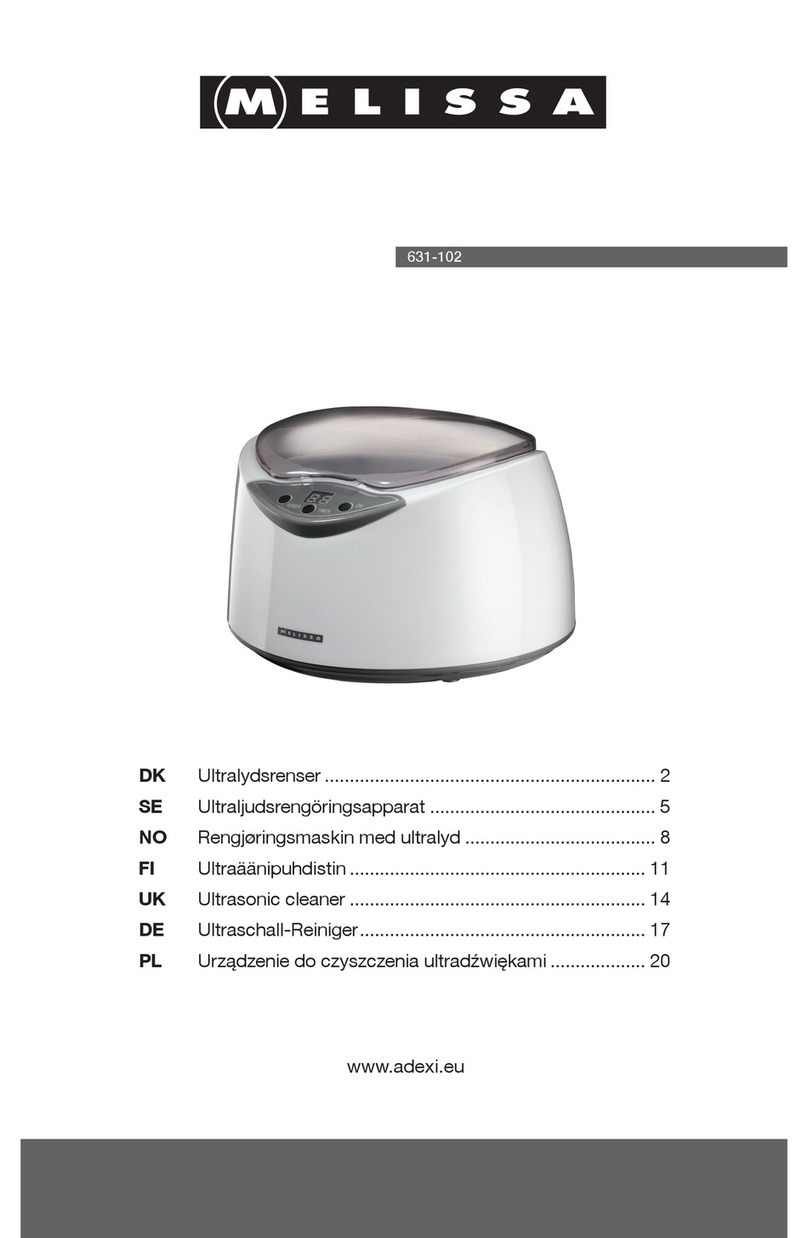
Melissa
Melissa 631-102 user guide

Belanger
Belanger DuraBlaster owner's manual
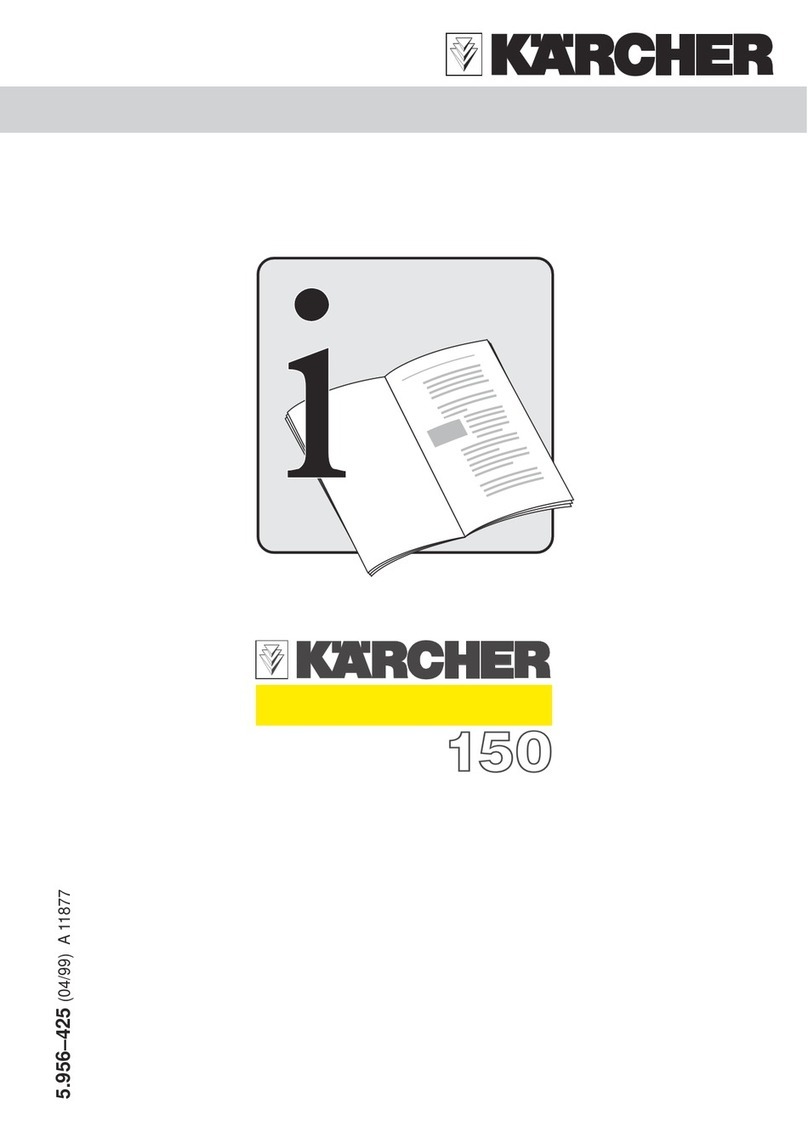
Kärcher
Kärcher 1.084 Series manual
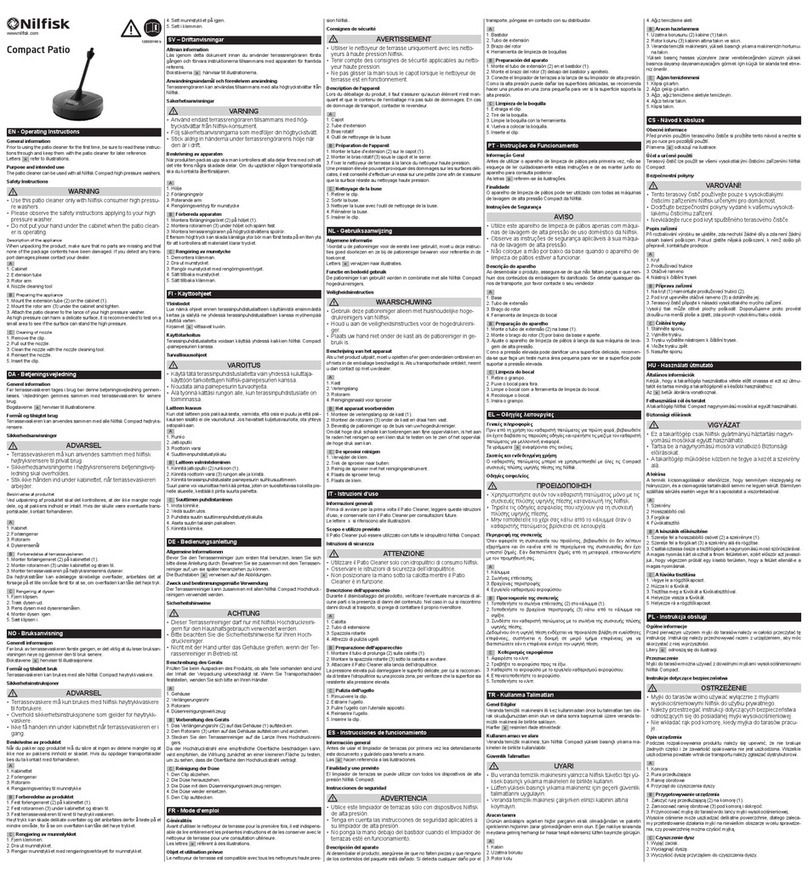
Nilfisk-Euroclean
Nilfisk-Euroclean Compact Patio operating instructions

Miele
Miele SEB 213 operating instructions
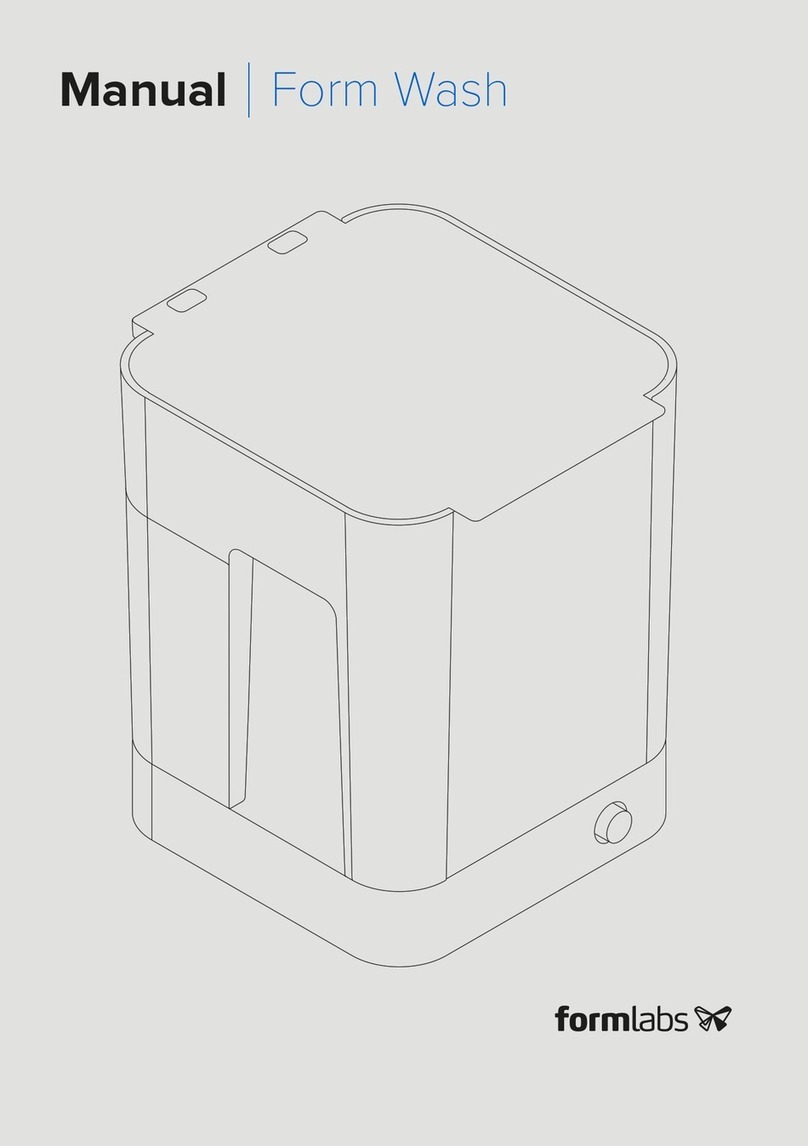
formlabs
formlabs Form Wash Installation and usage instructions
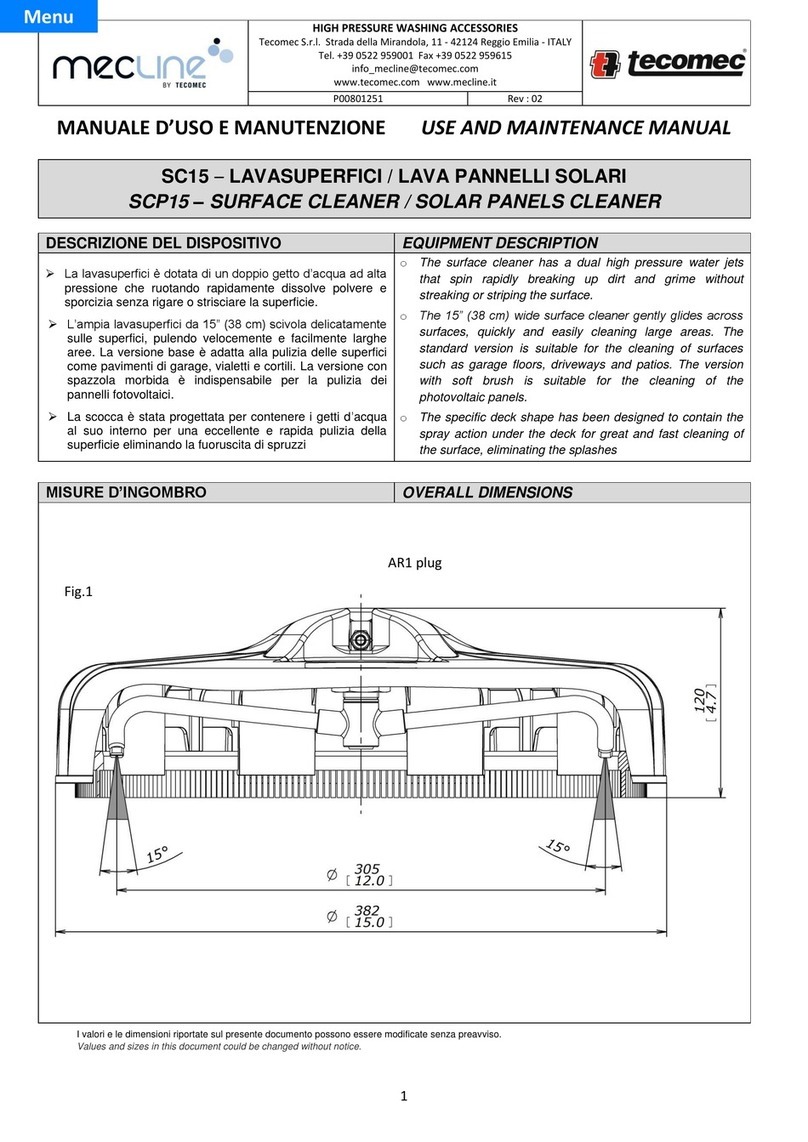
Tecomec
Tecomec Mecline SC15 Use and maintenance manual

Kränzle
Kränzle Round Cleaner UFO light operating manual


